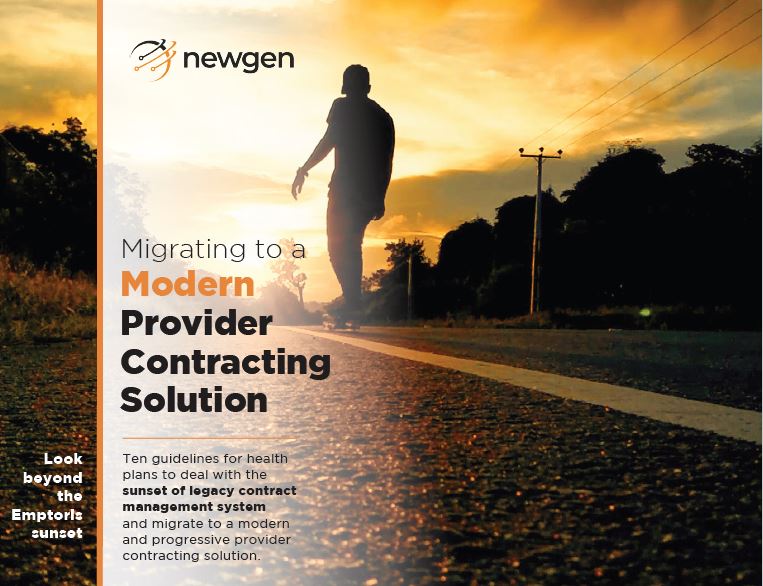The Urgent Need for Migration
Provider contracting sits at the heart of every health plan’s operations. It defines the foundation of relationships with healthcare providers, impacts claims accuracy, ensures regulatory compliance, and directly influences patient satisfaction. Yet, many health plans continue to rely on legacy systems like Emptoris, which are nearing sunset or have already reached end-of-life.
As regulatory complexity increases and provider networks expand, it has become imperative for health plans to migrate to a modern, intelligent, and compliant provider contracting solution. This eBook lays out ten essential capabilities health plans must consider during migration to ensure business continuity and long-term operational efficiency.
1. Interview Wizard and Smart Templates
Provider contracts vary widely by type, network, and region. A one-size-fits-all approach no longer works. Health plans require intelligent tools that can automatically determine the right contract structure based on predefined business rules.
Key Considerations:
- Interactive decision-tree based questionnaires for automated template selection.
- Rule-driven contract generation for speed and accuracy.
- Built-in compliance with Medicare, Medicaid, and commercial line requirements.
Business Value:
This feature ensures accuracy, standardization, and regulatory alignment while reducing manual errors and contract creation time.
2. Automated Migration of Existing Contracts
Migrating thousands of provider contracts, each with unique terms, amendments, and metadata, is a complex task. Manual migration risks errors and data loss, leading to compliance breaches and operational delays.
Key Considerations:
- Data mapping from old to new systems with validation checks.
- API-based migration of documents, metadata, and relationships.
- Automation scripts to ensure fast, error-free transitions.
Business Value:
Automated migration minimizes risk, maintains data integrity, and accelerates time-to-market.
3. Digitization of Contracts
Provider contracting is document-heavy and paper-reliant in most health plans. Transitioning to a fully digital contracting system enables faster collaboration, easy retrieval, and improved compliance.
Key Considerations:
- Centralized document management with tagging and search capabilities.
- Role-based access controls and metadata mapping.
- Integration of digital signature workflows for secure contract execution.
Business Value:
Digitization ensures traceability, faster contract turnaround, and full audit readiness.
4. Enterprise-Wide Integration
Modern provider contracting cannot function in isolation. It must connect with core systems such as claims, credentialing, provider directories, and third-party data sources.
Key Considerations:
- API-driven integration for real-time data synchronization.
- Two-way communication between systems to ensure consistency.
- Direct data exchange with external sources like CAQH.
Business Value:
Seamless data flow improves accuracy, reduces manual entry, and enhances member experience.
5. Mass Amendments
Regulatory updates and policy changes often require simultaneous modifications across hundreds of contracts. Doing this manually is inefficient and error-prone.
Key Considerations:
- Ability to apply batch amendments using predefined templates.
- Metadata-based search to identify impacted contracts.
- Batch verification and approval workflows.
Business Value:
Mass amendment capability saves time, reduces errors, and ensures uniform compliance across all provider contracts.
6. Centralized Archival and Storage
Contracts must be accessible across departments for auditing, reference, and regulatory compliance. A centralized repository ensures everyone works with a single source of truth.
Key Considerations:
- Secure digital repository with role-based access.
- Advanced search and tagging features for quick retrieval.
- Support for archival of both active and historical contracts.
Business Value:
Centralized storage enhances visibility, reduces duplication, and supports collaborative workflows.
7. Servicing and Configuration
Provider data must remain accurate across multiple systems. Manual updates increase the risk of outdated records, impacting provider satisfaction and compliance.
Key Considerations:
- Multi-channel service request initiation (portal, email, phone, etc.).
- Automated updates of provider demographics into the core system.
- Real-time notifications for provider status or configuration changes.
Business Value:
Automated servicing ensures up-to-date provider data, faster resolutions, and higher satisfaction.
8. Reporting and Monitoring
With compliance requirements tightening, health plans must maintain real-time visibility into contract status, renewals, and amendments.
Key Considerations:
- Dashboards for tracking contract lifecycle progress.
- Alerts for pending renewals, expirations, and service requests.
- Exportable reports in multiple formats (CSV, XLS, PDF).
Business Value:
Improved oversight reduces compliance risks and supports data-driven decision-making.
9. Contracting Process Automation
Disconnected systems often cause delays in provider onboarding and contracting. Automation helps orchestrate workflows end-to-end, ensuring collaboration and speed.
Key Considerations:
- Workflow-driven contract lifecycle management.
- Automated notifications and rule-based task routing.
- Real-time visibility into progress through dashboards.
Business Value:
Automation streamlines processes, cuts turnaround time, and eliminates silos across teams.
10. Extensibility and Scalability
Replacing a legacy system should not be a short-term fix. The new solution must support future scalability and extend beyond contract management into unified provider lifecycle management.
Key Considerations:
- Configurable platform with modular architecture.
- Unified workflows across contracting, servicing, and credentialing.
- Flexibility to adopt new business models and regulatory updates.
Business Value:
An extensible platform enables continuous innovation and prepares health plans for future growth.
Measurable Impact: Case in Point
A leading US health plan implemented Newgen’s modern provider contracting solution and achieved:
- 35 percent faster turnaround time.
- 40 percent reduction in operational costs.
- 95 percent improvement in compliance.
This transformation demonstrates the strategic value of migrating to a unified and intelligent platform.
Why Newgen?
Newgen’s AI-driven provider contracting and lifecycle management solution enables health plans to move beyond fragmented systems and manual inefficiencies.
Key Capabilities:
- Unified platform for contract lifecycle management, servicing, and configuration.
- Built-in document management and workflow automation.
- Compliance-ready architecture supporting regulatory mandates.
- Extensible design for integration with core and third-party systems.
Business Outcomes:
- Improved compliance and audit readiness.
- Faster contracting and onboarding.
- Reduced administrative costs.
- Enhanced provider satisfaction and member experience.
The Path Forward
The sunset of legacy systems such as Emptoris presents an opportunity for reinvention, not just replacement. Migrating to a modern provider contracting solution enables health plans to achieve agility, transparency, and compliance all while setting a foundation for next-generation healthcare delivery.

